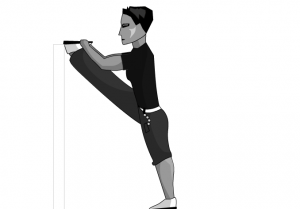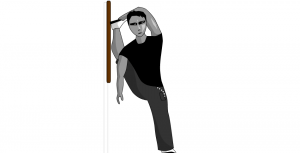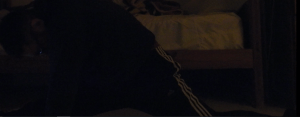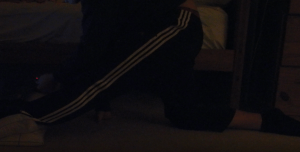As I’ve previously discussed in these hallowed pages, I feel that flexibility is an aspect of physical fitness training that many men ignore, largely due to perceptions of it being “effeminate.” In those articles, I sought to debunk that narrow-minded belief, as well as advocating stretches one can do to generally improve one’s health and well-being. In my “relax into stretch” article, I discussed how that technique can be used for the ultimate stretch, the alpha and omega and standard bearer of flexibility: the split

Every man should incorporate splits in his workout for a variety of reasons: the increased flexibility and mobility, the training of willpower and tolerance to pain, increased power in striking for martial artists, and last but not least, the sex appeal. But undoubtedly, for the trainee in flexibility, the split seems an impossibly daunting task.
Having taught you how to stretch without literally forcing the muscle fibers to stretch (and thus risk tearing), I can now teach you a series of “intermediate” stretches that will train those muscles that are stretched in a split. These stretches should be done as a warm-up before actual split training.
First, the front split stretches:
The Kneeling Hip Flexor
When you are training the front split, the two predominant muscles being stretched are the hamstring of the front leg, and the hip flexor and gluteus of the back leg. Thus, it is imperative that you at least warm-up with stretches that specifically target those muscles.
To do the kneeling hip flexor stretch, kneel on the floor with one foot on the ground in front of you, and one knee behind you. Placing your hands at your sides, lean forward, stretching out the hip flexor of the hind leg.

Hold this until the pain subsides, then stop and switch legs. After a few sessions of this, you can increase the stretch by moving the back leg further back.
The Double Hamstring
The one you remember from elementary school. Sit down on the floor with your legs extended. Lock your knees and bend at the waist, touching the fingers to the toes.

Much like all stretches, hold until the pain subsides. After a few sessions, you can increase the stretch by touching the palms of your hands or your wrists to your toes, as I am doing in the picture
The Stretchkick
Common in martial arts curricula, this stretch is useful for both the front split and the side split. Stand approximately three feet from a shelf, Swedish ladder, or something similar (you can use a wall, but preferably use something that has levels, as it has lower rungs that you can utilize if you cannot get your leg all the way up). Keep your feet closed and parallel.
Stand upright and with a “hollow back” (i.e. not rounded), lift your leg up and put your heel on the wall, keeping the leg straight, your feet straight, and your hip parallel to the wall

Grasp the ball of the stretched foot with both hands. Lock both knees and keep your hips low—do NOT raise one hip or the other. Lean forward slightly, but keep the back straight, avoid torso or hip twisting. Pull the tip of the foot down, try to look at the bottom of your foot while keeping your head high and your back straight.
The ultimate goal of this stretch is to have your foot parallel to your head, but most likely you will not be able to do this immediately. This stretch can also be done with your side to the wall. and your foot turned 90 degrees from the other foot

Side Split Stretches
The front split is the easier of the two, which is why I focused on it first. But of course, for the sake of completion, the intimidating side split must be discussed as well.
The Half Side Split
This stretch, sometimes referred to as the Cossack stretch, is a stretch that opens up the hips and targets the muscles of the groin, both of which are predominantly hit in the side split.
Stand with your feet three shoulder widths apart, and bend on one leg. The other leg remains fully extended.
Touch the floor with both hands and press the inside of the thigh of your bent leg away with the corresponding elbow. Keep your back straight

Hold until the pain subsides, and try to open up the hips further by moving your body down. Then do the other side.
Wide Leg Toe Touch
This is not actually a touching of the toes, but the motion is the same. Standing up, spread your legs 2-3 shoulder widths. Lock the knees and bend forward, touching the floor with your hands. The back and arms should be straight. Hold until the pain subsides
Once you do this easily, the way to make it harder is to not move your feet farther apart, but rather to grab the calves and pull the upper body towards the legs. Pull your stomach in towards your hips.

The Scissor Split
Sit on the floor and split the legs at least 90 degrees. Then grab the feet and bend forward, keeping the back straight and the knees locked. Try to touch your stomach to the floor, and then pull yourself forward and widen the split (after you’ve relaxed into the stretch, of course).

And last but not least, try to do actual splits, remembering your PNF and relaxation techniques. I feel that the length of the hold is more important than forcing the stretch. In other words, doing 75-80% of your maximum stretch and holding that for 20 minutes is better than doing 100% of your maximum and only holding it for 1 minute.

Personally I find that sweatpants and socks make it easier to slide the hind leg back, but whatever works for you.
Conclusion
Using these techniques, I have greatly increased my flexibility, which has for many years been poor.

As you can see I cannot do a full split just yet, but considering that when I started a serious flexibility regimen my split looked more like:

and now I have progressed to the stretch in the second to last picture, I feel I have made a tremendous about of progress in a short time, and by the end of the year I expect to be able to do both types of split, if not sooner.
Read More: Why You Should Be Doing The Twist Stretch
Kumite! Kumite! Kumite!
What a great movie that was. A white man entering an Asian martial arts contest full of chinks and kicking the ass of them all. Can you imagine the outrage it would be today?
The outrage then and the outrage now would be you referring to Asians as “chinks” you racist imbecile.
I think you’re in the wrong page, spic.
What is funny is that reading your Disqus comments, you hold a very bad opinion of Indians and other people in general, bitching like some whining pussy about them and yet, calls people racist. But living in San Fagcisco I wouldn’t expect any different from you. What a putz. Go find some different strain of AIDS to infect yourself, maggot.
I describe the issues with H1bs and third world personalities of Indians. I don’t go about calling them brownies or camel jockies or sand niggers. You on the other hand, would probably call a black person a nigger. Get your facts right dumb idiot.
I’m in the perfectly right place. Calling me a spic when your name is “Salgado”. Once again, showing your true racist nature. And btw, I’m half Italian/Half Portuguese. Nice try.
Portuguese. Pffffft. It figures. Fucking paneleiro. You keep sounding like some SJW whiny liberal bitch. I think you should go post at the Slate or other safe place.
Hey, PORTUGA de merda, cala-te caralho. Is that factually rigth wnough for you, bozo?
I just laugh at the imbecile you are.
If I’m a SJW, you’re a beta cuck.
Hey porkchop, you’re still flapping those gums?
Learn to write English first you fake imbecile.
I just kept that OBVIOUS key-proximity typo (not spelling error) there to see you act like the EXTREMELY stupid individual I already knew you were and just waited your fat 1/2 dago 1/2 porkchop dumbass to go all spelling nazi on me. What are maroon. You’re dismissed, yet-another-random-internet-kick-toy.
We secretly know you want to stick your tongue in my ass to taste the turd.
“But Brick not hit Back” Lol
Of course, listening to “Come Steal the Night” makes splits easier.
For martial arts, the front splits is more useful but being able to do both is even better of course. I like doing the kneeling hip flexor. I’ll lean forward and then lean back, straighten out the front leg and stretch the hamstring. Back and forth and also slowly spreading the distance between my feet.
Also in addition to the splits, you need to make sure to work on your strength through these increased range of motions. Static active stretches (like wall kicks) and PNF stretches will help.
Oh wow! I always wanted to learn how to do this! Ever since I saw “Bloodsport” and good ole VD was doing the splits I wanted to do this to impress the ladies!
Glad to have helped.
This is an interesting article. Anyone who wants to take it further should do a Google search for Matt Furey’s lessons on doubling your flexibility. If you can find a YouTube video, watch that as well. It was a good video that will help you double your flexibility in one evening.
..
In my opinion, mobility trumps flexibility and stretching does not lead to mobility, especially if you use static stretching. Dynamic stretching is superior in my opinion because it gives you the stretch and the mobility work in one move. Combine that with dedicated mobility work and you are set.
In the context of the human body, “flexibility” actually doesn’t make any sense. Do you want your bones to be flexible? Probably not. What you are looking for is a mobile joint and responsive connective tissue. It is extremely mobile joints that allow one to do the splits.
That said, the splits looks cool but is not really necessary for a fighter. What you really want is responsive hamstrings that won’t tighten at an inopportune moment leading to a tear. I have experienced this and it is not pleasant.
What usually causes tears in the hamstring is usually not a lack of flexibility but actually instability in another area of your body (usually the pelvis) leading to overloading of the hamstring and hence a tear.
Stability is probably the most important aspect of physical fitness that you can work on. A house built on sand will collapse.
Dynamic stretching is great, but I disagree with the idea of splits not being necessary for a fighter. I feel that my kicks have been greatly improved with flexibility training. Also, flexibility training in general is great for grapplers, as it helps them get out of holds.
But yes, I agree with the idea that the connective tissue and bones should not be flexed at all. I’ve said that in other stretching-related articles.
I won’t argue that “flexibility” training won’t help your kicks but the movement pattern of doing the splits is completely different to throwing kick. This is why the splits per se is not necessary. There is some cross-over sure but at least as far a Muay Thai round kick is concerned there are many other factors involved. A kick is a dynamic movement and it would seem to me that the way to improve a particular dynamic movement is to practice that specific dynamic movement. Flexibility training is one way to provide complementary benefits but I would also recommend stability training as well as this is a key component of maintaining strength through the kick and reducing the probability of injury.
I stopped doing static stretching years ago and have noticed no deterioration in my kicks. More to the point, it is my opinion that stretching muscles weakens them and increases the probability of a tear. Just my opinion, I’m not an expert on human physiology.
Thanks for the article though Larsen. They are always a good read.
I wonder if you or englishbob would recommend a training regimen. Fast approaching 50, very poor flexibility, low back pain etc. weight train three days each week and no matter how much stretching I perform I snap right back to tight tight tight. A good book or proscribed system? Thanks for a great article.
I’d recommend Pavel Tsatsouline’s “Relax into Stretching” as a resource for general knowledge. It’s what I used to learn stretching. Also, incorporate bridging into your workout, which was the subject of my very first article.
As for a routine, I must recommend the routine I give in my website’s PDF.
Thank you very much.
Good post. Dynamic stretching will also allow you to kick at a moments notice reducing risk of injury in a self defense situation. Being flexible is great but if you can’t throw a good kick without 20 minutes of static stretching then it’s a waste of time if you need to defend yourself
The older you get, the more you have to stretch or else you will be prone to injury. I use to have a sore back most of the time but now I stretch for at least 5 minutes a day and rarely have any injuries now.
When your muscles are tight, your posture is off where you won’t be able to perform a correct “full” (ROM) movement.
Best time to stretch when you don’t have the time is in front of the TV where stretching detoxificate your system and helps you sleep!
Stretching is the least fruitful fitness endeavour for adults. If your hips are not built a certain way, splits training is completely useless and will only wear you out. I learned this the hard way. I found out what parts of my body respond to stretching and which ones don’t. If it was not for the hyperbole about it being “will power” or other stupid shit I would have concentrated my attention on useful tasks much earlier.
Have you noticed how these esoteric martial arts emphasize flexibility and the ones that work in the ring do not? It’s probably done to create an illusion of power as if those skills have anything to do with fighting. They don’t. You can kick someone in the head if you can touch your toes but in any case the blog’s love of violence (calling it “masculinity”) is misguided in my opinion.
While I’d agree that some people have it easier than others in terms of flexibility, I’d have to disagree with the idea that practical martial arts don’t focus on flexibility. Wrestling, Jiujitsu, Muay Thai, Sanshou Kung Fu, and Kyokushin Karate (to name a few) do extensive flexibility training (perhaps not necessarily the splits, but flexibility work is done).
And, as I’ve said in other articles, the training it gives in terms of sheer pain resistance is worth doing on its own, which is why the Spetsnaz demands its recruits to do both kinds of split.
I’m not trying to say you’re wrong but I assume you’re going by what you’ve read about the spetsnaz from a third source. I remember reading similar stuff and no offense to you but I think it could well be a myth or practice that no longer occurs today. The reason I have a very hard time believing this is because a lot of people don’t have the right body type to do the splits (or move their arms or shoulders or jaws in a certain way; genetics) and you need to start training before the age of 11 if you want to modify those structures. Grown ass men cannot defy their genetics anymore. Injuring their recruits with such training would not do much for their efficiency as soldiers. Sometimes that which does not kill you makes me weaker for the rest of your life.
I’m just going off what Pavel Tsatsouline says in his book.